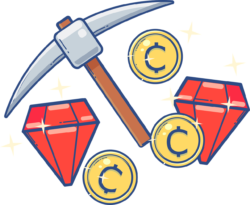How Do I Start Mining Ethereum?
How do I start mining Ethereum? This is a question many aspiring cryptocurrency miners have asked themselves, and it’s a good question. In this blog post, we’ll explore the process of starting as a cryptocurrency miner and provide some tips for mining Ethereum successfully. Let’s dive in!
What is Ethereum?
Ethereum is a decentralized platform, meaning that its network is made up of individual users’ computers. These users help run the platform by processing the network’s transactions in exchange for Ether, Ethereum’s cryptocurrency.
Ether can also be exchanged or sold, just like any other cryptocurrency. Ethereum differs from Bitcoin and other digital currencies because it is designed for business use rather than just for buying and selling goods.
Ethereum allows users to create their own applications on top of the Ethereum network, similar to Bitcoin. But Ethereum is different in that the applications created on it can be more complex.
This is often thought of as “the business blockchain.”
Ethereum uses blockchain technology to create smart contracts, or self-executing agreements, that control assets. Smart contracts allow Ethereum users to write applications to handle contracts, agreements, securities, and more.
What Do You Need to Start Mining Ethereum?
If you’re new to mining Ethereum, this guide covers all the important facts in a simple, low-jargon way. Let’s start with some short answers to common questions:
What are the basic requirements?
Before you can start mining Ethereum, you need to have a few things set up. Firstly, you’ll need to have a strong and reliable internet connection. Secondly, you’ll need to have a computer that is powerful enough to mine Ethereum. Lastly, you’ll need to have a mining software program. Ethereum mining software is what helps you connect your Ethereum mining hardware to the blockchain and your ETH wallet.
Once you have all of these things set up, you can start mining Ethereum. Also, don’t forget to set up your Ethereum wallet. The ETH wallet will serve as your personal record of all the Ether you mine and is also used to send and receive ETH.
Is mining Ethereum worth it?
Short answer: Probably not.
Longer answer: Ethereum mining is currently unprofitable for individuals. How long this will continue is impossible to say, as ETH mining difficulty and ETH price are both highly dynamic. However, large-scale ETH miners (e.g., mining pools) could still be profitable if they have access to cheap electricity and low-cost maintenance.
How does Ethereum mining work?
In Ethereum mining, nodes run special software to solve math problems. And, just like Bitcoin mining, Ethereum mining uses a lot of electricity. It is a delegated proof-of-work algorithm. This means that miners verify and process transactions for Ethereum, and in return, they receive Ethereum tokens (ETH).
Miners are rewarded with ether for each successful transaction they process, as well as receiving gas costs (like transaction fees) paid by users sending transactions.
Mining provides security for the Ether ecosystem: If someone tries to build a fraudulent transaction that isn’t considered by the network as valid (like spending someone’s else coins), everyone else would simply ignore it and would not add it to their blockchain copy – meaning this invalid transaction would quickly become nowhere and nobody would know who committed this fraud!
So we see that miners play a vital role in ensuring that transactions behave correctly, which leads us to our next topic…
How to Start Mining Ethereum?
Let’s take a look at the steps you’ll need to take to start mining.
Step 1: Choose your mining hardware
The days of mining with your CPU only are gone. GPUs are a must-have when it comes to mining Ethereum.
There are two main types of mining hardware: GPUs and ASICs. GPUs are much more effective at mining Ethereum than CPUs and can do so at a significantly lower power draw.
ASICs, on the other hand, are specifically designed for mining Ethereum and offer significantly higher hash rates while also consuming much more power.
If you’re serious about mining Ethereum, then you’ll want to invest in a high-quality Ethereum ASIC miner. However, if you’re just starting out or on a budget, then a mid-range GPU like the GTX 1060 or GTX 1070 will do the trick.
Step 2: Join a mining pool
Mining pools are simply groups of miners that work together to mine Ethereum. The miners combine their efforts to increase their chances of earning Ethereum. Then, they share the rewards equally.
The two most popular Ethereum mining pools are Ethermine and Nanopool, which together account for around three quarters of the network hash rate. There are many other smaller pools that compete for the remaining hash rate.
There are two popular types of mining pools: Solo mining pools and PPLNS pools.
Solo Mining Pools: Solo mining is when you mine Ethereum by yourself. This isn’t recommended for beginners. If you choose to mine solo, then you will need to invest heavily in Ethernet hardware as well as have a very good understanding of the Ethereum network and blockchain. This option gives miners the full reward for their efforts, but it also comes with risks, as small changes in the network can result in very large swings in profitability.
PPLNS Mining Pools: PPLNS stands for Pay Per Last N Shares and is a more advanced way of mining for ETH. In a PPLNS system, miners are only paid based on the last N shares they submitted while solving a block, regardless of how many blocks were solved during that period. This N can be tailored to each pool but is generally around 200-1000 shares.
Step 3: Install the mining software
If you’re going to use Windows, then you’ll need mining software. The easiest way to do this is to download the free ethOS operating system. This will give you a disk image that you can burn to a USB drive. Boot from the USB drive, and you’re good to go!
Once you have ethOS installed, you just need to configure it to start mining Ethereum. The best way to do this is with the remote config file, which you can upload to your rig via a USB drive. The file contains all the necessary settings for your rig, so all you need to do is edit it with your wallet address and mining pool details.
You can also use tools like MultiMiner or EasyMiner, which support multiple mining pools and devices. These are more complex to set up but can be more efficient if you have multiple rigs working together.
4: Profit!
Once you have your rig set up, you just need to plug it in and let it run. Depending on the hardware you use and the efficiency of the mining software, your earnings will vary.
You will need to run your rig 24/7 to make any significant profits, though Ethereum mining rigs consume large amounts of electricity. Like Bitcoin mining, Ethereum mining is competitive. This means that not only is it difficult to get large returns in a shorter period of time, but mining costs can also get quite high.
Ethereum Mining Profitability
Mining Ether can be an incredibly profitable endeavor. The cryptocurrency market is growing at an astonishing rate, and Ethereum is leading the pack. Sadly, however, mining rigs are very expensive, and they consume vast amounts of electricity. If you’re not careful, you could end up spending more on electricity than you make in profits.
To be profitable, you’ll need to choose a mining rig that suits your budget and energy needs. You’ll also need to factor in the cost of Ethereum itself. Thankfully, there are a number of websites that can help you calculate your potential profits.
Conclusion:
Mining Ethereum is a complicated process; it involves purchasing specialized hardware and software. However, people have found ways to simplify the process. In this blog, we provided an overview of the easiest ways to get started with Ethereum mining.
I hope this article was helpful. If you have any questions or want more information about Ethereum mining, let me know in the comments below – I’d love to hear from you!
Click here if you want to read an excellent article which deals with more details about Ethereum mining.
FAQs
What Do I Need to Start Mining Ethereum?
All of the following is required for you to succeed as an Ethereum miner:
a wallet for Ethereum to store all of your just acquired money;
drivers for GPUs;
an application for mining (such as Minergate or Claymore miner);
If you plan to mine inside a mining pool, the address of the mining pool;
a GPU (graphics card) with a minimum of 3GB of RAM;
How Long Does It Take to Mine One Ethereum?
Mining one Ethereum requires roughly sixty days, given the current degree of difficulty.
Can I Mine Ethereum on my Phone?
AA Miner One mining app made especially for Android smartphones is called AA Miner. Numerous cryptocurrencies are supported by the program, such as Zcash, Ethereum, and Bitcoin. In addition, AA Miner has several features like a built-in wallet, a referral program, and multi-device mining.


